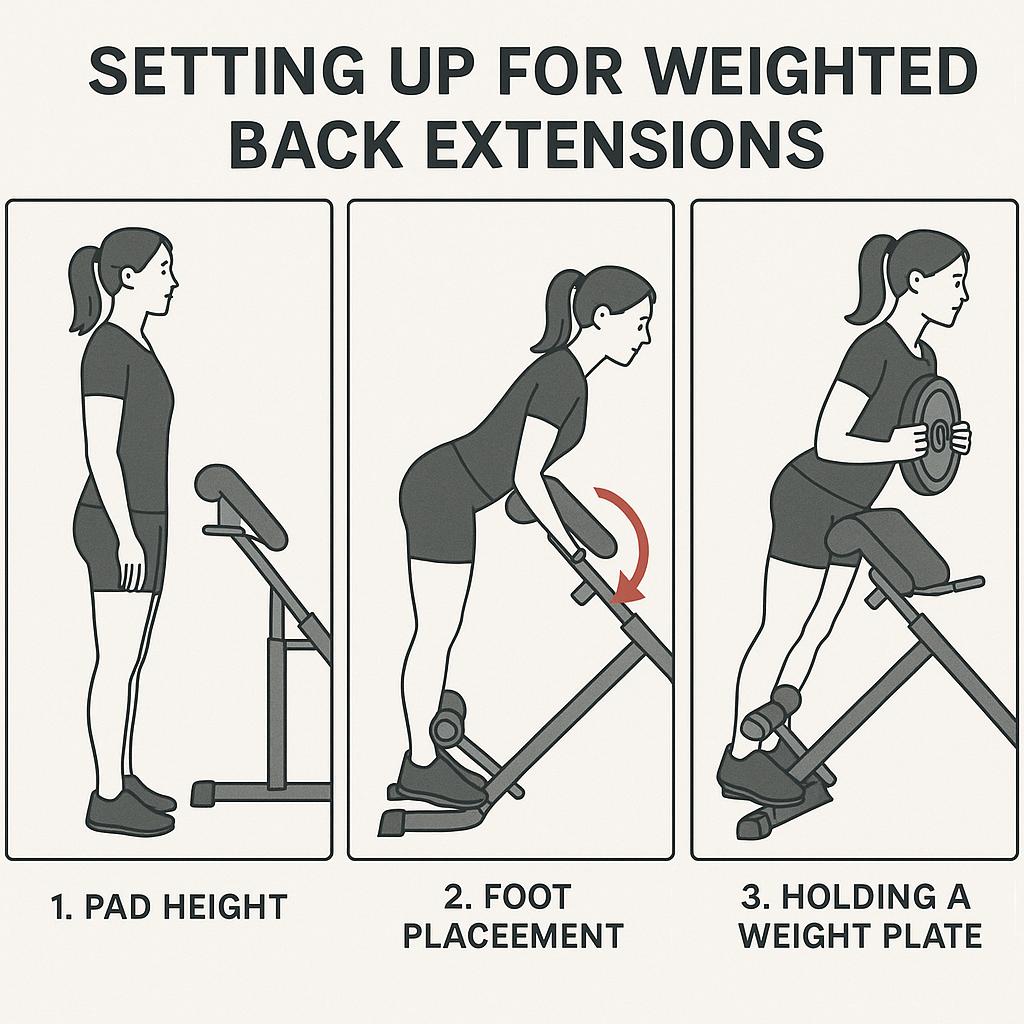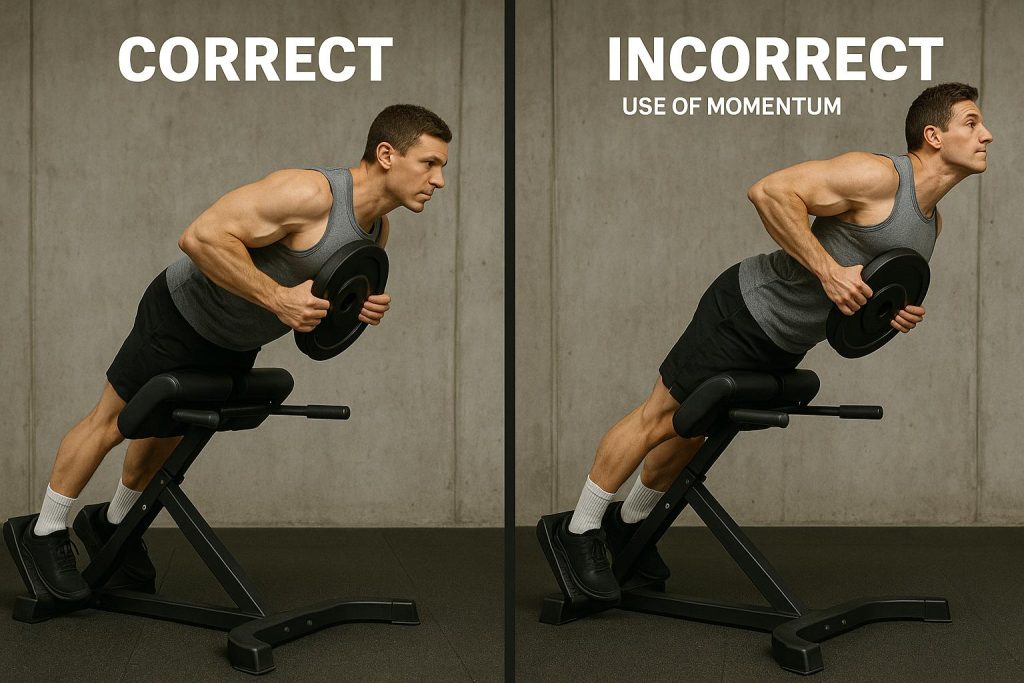Weighted back extensions are one of the most effective ways to strengthen your lower back, glutes, and hamstrings, but proper form is essential for safety and results. Mastering the correct technique ensures you build a strong posterior chain while avoiding common injuries. Knowing how to do weighted back extensions the right way is key for anyone looking to improve core strength, prevent lower back pain, and boost overall athletic performance.
In this guide, you’ll learn exactly how to set up, execute, and progress with weighted back extensions safely—plus tips, benefits, common mistakes, and real-world examples. Let’s get straight to it.

For official guidance, check out the American Council on Exercise Back Extension Guide.
What Are Weighted Back Extensions?
Weighted back extensions (sometimes called hyperextensions) are a strength-training exercise that targets your lower back, glutes, and hamstrings. Unlike traditional bodyweight back extensions, you add resistance using a weight plate, dumbbell, or weighted vest for extra challenge and muscle growth.
- Main muscles worked: Erector spinae, glutes, hamstrings
- Equipment options: Roman chair, 45-degree hyperextension bench, stability ball, GHD (Glute Ham Developer)
- Ideal for: Athletes, lifters, and anyone seeking a strong, injury-resistant lower back
According to Men’s Health (2024), weighted back extensions help support proper posture and prevent back injuries when performed correctly.
How to Set Up for Weighted Back Extensions

1. Choose Your Equipment
- Roman chair or hyperextension bench: Most common for gyms.
- Stability ball: Great for home use, but more challenging for beginners.
- Glute ham developer (GHD): Advanced athletes may prefer this for deeper range.
2. Set the Pad Height
- The pad should rest just below your hip crease. Too high and you’ll lose full range of motion; too low and you may lose stability.
3. Secure Your Feet and Ankles
- Lock your feet firmly under the foot pads or rollers. This ensures your lower body stays stable.
4. Hold Your Weight
- Beginners: Hold a weight plate or dumbbell at your chest.
- Intermediate: Hold behind your head or use a light weighted vest for more challenge.
- Advanced: Progress slowly—focus on form over heavy weight.
Step-by-Step: How to Do Weighted Back Extensions

1. Starting Position
- Stand with your thighs against the pad, feet secured.
- Hold your weight at your chest, keep your spine neutral, and cross your arms if using no weight.
2. Lower With Control
- Hinge at your hips, not your lower back.
- Lower your torso slowly until your upper body is about 70–90° to your legs.
- Maintain a neutral spine (don’t round your back).
3. Raise to Neutral
- Drive your hips forward and contract your glutes and hamstrings.
- Lift your upper body until you form a straight line from head to heel.
- Do NOT hyperextend your back past neutral!
4. Repeat With Perfect Form
- Perform slow, controlled reps—no swinging or jerking.
- Recommended tempo: 2–3 seconds down, 2 seconds up.
Watch this YouTube demonstration by ScottHermanFitness for proper form:
Benefits of Weighted Back Extensions

- Strengthen Your Posterior Chain: Builds strength and muscle in your lower back, glutes, and hamstrings. Enhances hip stability and power.
- Support Core and Posture: Stabilizes your entire core, helping to prevent low back pain and injury. Improves posture, especially for those who sit often.
- Boost Athletic Performance: Essential accessory exercise for deadlifts, squats, and sports that require explosive hip extension.
According to a 2024 StrengthLog study, weighted back extensions are among the top three exercises for reducing chronic low back pain when performed with proper technique.
Recent ACE research (2024) confirms that progressive overload with weight increases strength and function for the posterior chain.
Common Mistakes to Avoid

- Pad too high: Limits range of motion, shifts tension away from glutes/hamstrings.
- Overextending: Going past neutral can strain your lumbar spine.
- Using momentum: Reduces muscle engagement and raises injury risk.
- Letting the back round: Always keep a neutral spine.
- Starting too heavy: Form always beats weight for long-term results.
Programming Tips: Sets, Reps, and Progression
| Experience Level | Sets & Reps | Weight Progression | Frequency |
|---|---|---|---|
| Beginner | 2–3 x 10–12 reps | Start bodyweight, add light plate | 1–2x per week |
| Intermediate | 3 x 10–15 reps | Gradually increase load | 2–3x per week |
| Advanced | 4 x 8–12 reps | Use heavier plate/vest | 2–4x per week |
- Start with bodyweight and only add weight once you can perform all reps with perfect form.
- Rest at least 48 hours between intense lower back sessions.
Pro Tips & Variations
- Glute focus: Squeeze your glutes at the top for extra activation.
- Single-leg back extension: Great for core and stability.
- Thoracic extension: Round your upper back slightly for glute emphasis (advanced).
- Use weighted back extensions as a warm-up or finisher for leg days.
Frequently Asked Questions
Is it safe to do weighted back extensions?
Yes, if you use proper form and progress gradually. Avoid hyperextending or using too much weight too soon. Consult a trainer if unsure.
Can you do these at home?
Absolutely! A stability ball and dumbbell work well for home back extensions.
How much weight should I use?
Start with a 5–10 lb plate and increase only when you can complete all reps with perfect form.
Are there risks or recent warnings?
Recent studies highlight overextension and excessive loading as the main risk factors (Harvard Health Publishing, 2024). Stay within your limits.
Conclusion
Mastering weighted back extensions is a powerful way to protect your back, boost athletic performance, and build muscle across your entire posterior chain. Start light, focus on form, and progress steadily for the best results. If you want to prevent back pain and maximize your strength, make weighted back extensions a staple in your workout routine.
